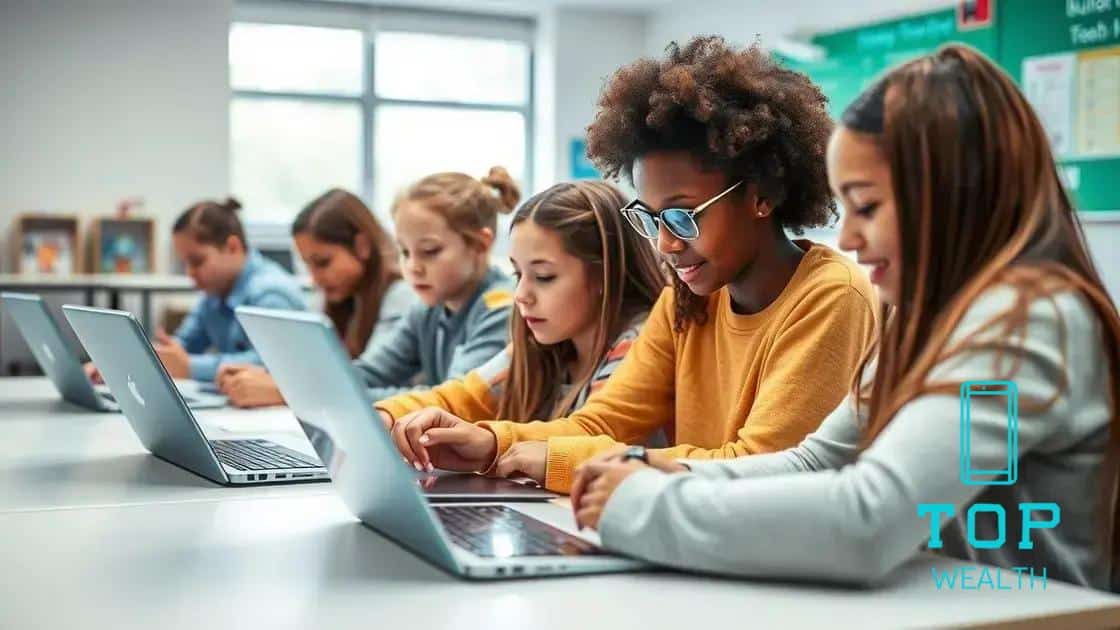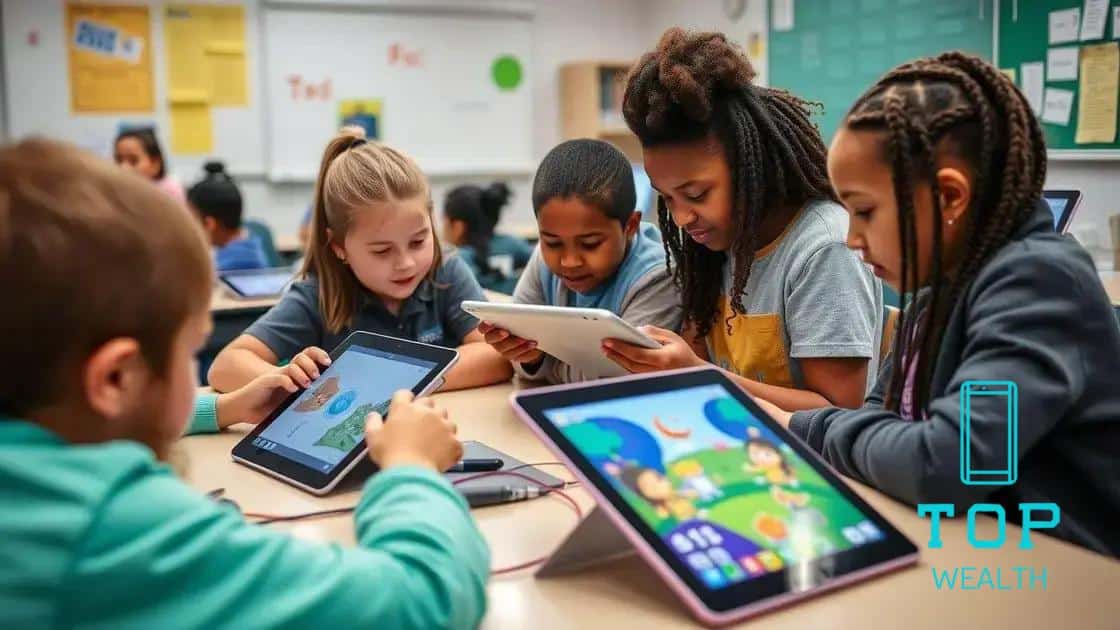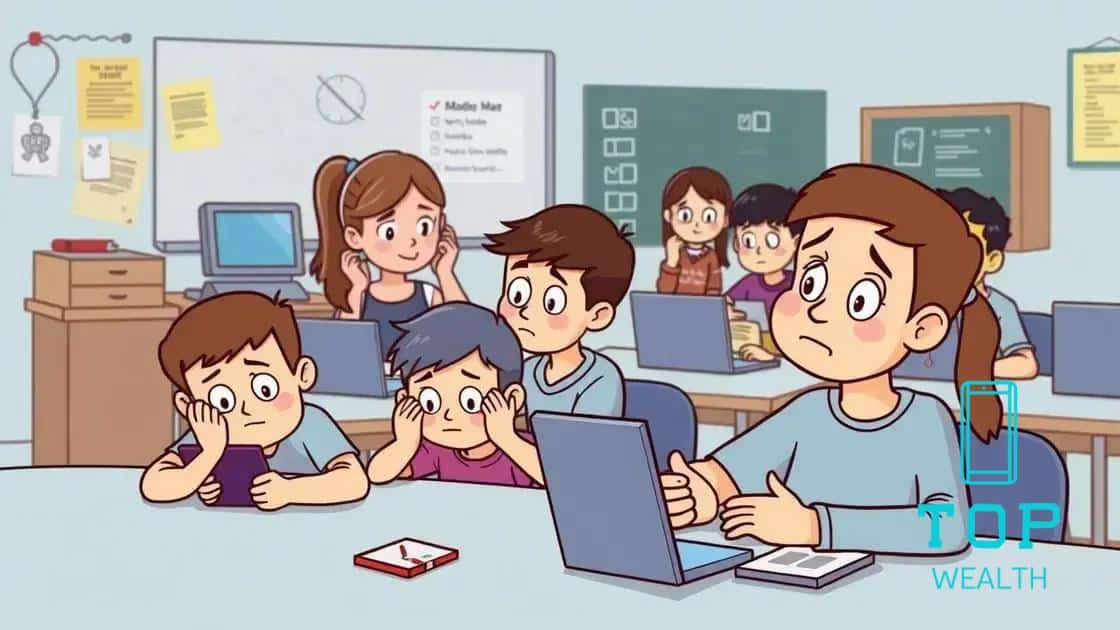Tech tools transform digital learning environments

Tech tools transform digital learning environments by enhancing engagement, facilitating personalized learning, and integrating immersive technologies like virtual reality, which together create interactive and effective educational experiences.
Tech tools transform digital learning environments, reshaping how educators and students interact with knowledge. Have you noticed how these tools can make learning more dynamic and interactive? Let’s dive into their transformative effects.
The rise of tech tools in education
The rise of tech tools in education has fundamentally changed how students learn and interact with information. As technology becomes more integrated into the classroom, teachers are finding new ways to engage students.
Benefits of Tech Tools
One major advantage of these tools is their ability to facilitate personalized learning. With various platforms available, students can progress at their own pace, allowing for a more tailored educational experience.
- Increased engagement through interactive content
- Access to a wealth of resources online
- Collaboration with peers through digital platforms
Additionally, tech tools can help bridge gaps in education by providing resources to underserved communities. Online learning environments allow students from different backgrounds to access the same quality materials. As we explore this trend further, it becomes evident that these technologies are not just supplements but essential components of modern education.
Types of Tech Tools
There are many different tech tools that are making an impact in educational settings. For instance, learning management systems streamline communication between teachers and students.
- Interactive applications for subjects like math and science
- Multimedia resources to enhance understanding
- Virtual reality experiences that bring lessons to life
This variety allows educators to choose tools that best fit their teaching styles and their students’ learning preferences. By embracing these technologies, teachers can transform traditional lessons into more engaging experiences. Over time, the presence of these innovations in classrooms will only continue to grow, ensuring that students are prepared for a tech-savvy future.
How tech tools enhance student engagement

Tech tools are crucial for enhancing student engagement in today’s classrooms. By integrating these tools, teachers can create more interactive and dynamic learning experiences. Students become active participants rather than passive learners.
Interactive Learning Experiences
When students use tech tools, lessons transform into engaging activities. For example, many classrooms now utilize educational games and interactive simulations. This helps maintain interest as students see learning as more fun and exciting.
- Games that reinforce concepts in math and science
- Simulations that allow for real-world problem solving
- Collaborative projects using online platforms
Moreover, technology facilitates immediate feedback. Students receive responses quickly, which keeps them motivated. They can track their progress in real-time, helping them understand their strengths and areas for improvement.
Collaboration and Communication
Another way tech tools enhance engagement is through collaboration. Digital tools allow students to work together efficiently, even outside of the classroom. This collaboration builds teamwork skills and encourages the sharing of ideas. Teachers can set up group projects using platforms like Google Classroom, where students can communicate and share their work easily.
- Real-time collaboration on documents and presentations
- Discussion forums for sharing insights and asking questions
- Video calls that connect students with experts
As a result, students feel more involved in their learning. They understand that their contributions matter, leading to increased motivation and better learning outcomes. Embracing such technologies is essential for fostering an engaging educational environment.
Integrating tech tools into traditional classrooms
Integrating tech tools into traditional classrooms can be a game-changer for both teachers and students. It involves blending new technologies with established teaching methods, enhancing the learning experience for everyone involved.
Understanding Integration
Tech integration doesn’t mean replacing existing practices but enhancing them. For example, teachers can use interactive whiteboards to make lessons more engaging. These tools allow for multimedia presentations, incorporating videos, images, and interactive exercises that can help clarify complex topics.
- Using apps for collaborative projects
- Incorporating online quizzes for instant feedback
- Engaging students through gamified learning experiences
The goal is to create a dynamic environment where students feel actively involved in their learning process. When students can use tools they are familiar with, their confidence and motivation often increase.
Training Teachers for Effective Use
To effectively integrate tech tools, teachers need proper training. Many schools hold professional development sessions focusing on how to incorporate technology into their teaching strategies effectively. By learning to use these tools, teachers can design lessons that resonate with today’s digital-savvy students.
- Workshops on utilizing specific software
- Training on managing classroom technology
- Sharing best practices among teachers
Moreover, teachers should be encouraged to experiment with different technologies. When they feel comfortable using the tools, they can better guide students in utilizing them for learning. This collaboration leads to more thoughtful curriculum development, which ultimately benefits the students.
Flexibility is crucial in integrating tech tools. Schools must be open to adjusting their methods as technology evolves. Embracing change not only benefits students but also prepares them for a future where technology will play a vital role in their lives.
Challenges of using tech tools in education

While tech tools bring many benefits to education, there are also significant challenges. Understanding these challenges is important as schools integrate technology into their classrooms. Some educators may struggle to adjust to new tools, which can create frustration.
Technical Issues
One of the biggest hurdles is dealing with technical issues. Technology can be unpredictable, and problems like slow internet or malfunctioning devices can disrupt learning. Educators often spend valuable class time troubleshooting these issues instead of teaching.
- Frequent system crashes during lessons
- Inadequate tech support from schools
- Compatibility issues between software and devices
Students may also lose interest if they encounter too many problems. This can lead to frustration and disengagement, undermining the goals of tech integration.
Training and Adaptation
Another challenge is the need for proper training. Many educators might feel overwhelmed when learning to use new technology. Without sufficient training, teachers may not utilize tech tools effectively, missing out on their potential benefits.
- Time-consuming training sessions
- Resistance to change among staff
- Varied levels of tech proficiency among teachers
This can result in inconsistent usage across classrooms, leaving some students with an unequal educational experience. Moreover, when teachers are not comfortable, they may avoid using these resources, limiting students’ exposure to valuable learning tools.
Additionally, access to technology can be uneven among students. Not all students have the same resources at home, which can lead to disparities in learning. Schools must address these equity issues to ensure all students benefit from tech tools.
Future trends in digital learning environments
The future of digital learning environments is bright, with many exciting trends emerging. As technology evolves, so will the way students learn and educators teach. Understanding these trends helps prepare for the changes ahead.
Personalized Learning
One significant trend is personalized learning. With the help of advanced algorithms and data analysis, education can be tailored to meet individual students’ needs. This ensures that lessons are suited to each student’s unique learning style.
- Adaptive learning platforms that adjust content based on performance
- Email alerts for teachers regarding student progress
- Customized learning paths that allow students to advance at their own pace
These tools give students more control over their education, leading to better engagement and outcomes.
Virtual and Augmented Reality
Another exciting trend is the use of virtual reality (VR) and augmented reality (AR) in classrooms. These technologies create immersive experiences, allowing students to explore new concepts in engaging ways. For instance, students can take virtual field trips to historical sites or conduct science experiments in a simulated environment.
- Interactive simulations for hands-on learning
- Virtual labs for experiments in science subjects
- AR elements that enhance textbooks and learning materials
By incorporating VR and AR, educators can make learning more memorable and impactful.
Moreover, the rise of artificial intelligence will continue to influence digital learning environments. AI can help automate administrative tasks and provide instantaneous feedback to students, allowing teachers to focus more on teaching. This technological integration promotes a more productive classroom.
The emphasis on collaborative learning will also grow. Online tools will encourage students to work together on projects, regardless of their physical location. This fosters a sense of community and allows for richer discussions.
FAQ – Frequently Asked Questions about Technology in Education
How can technology enhance student engagement?
Technology enhances student engagement by making learning interactive and personalized, allowing students to actively participate in their education.
What are some examples of tech tools used in classrooms?
Examples of tech tools include interactive whiteboards, educational apps, and virtual reality experiences that cater to various learning styles.
What challenges do teachers face when integrating technology?
Teachers may face challenges such as technical issues, the need for training, and ensuring equal access to technology for all students.
How does personalized learning work in a digital environment?
Personalized learning uses data to tailor education to individual students’ needs, allowing them to learn at their own pace and style.





